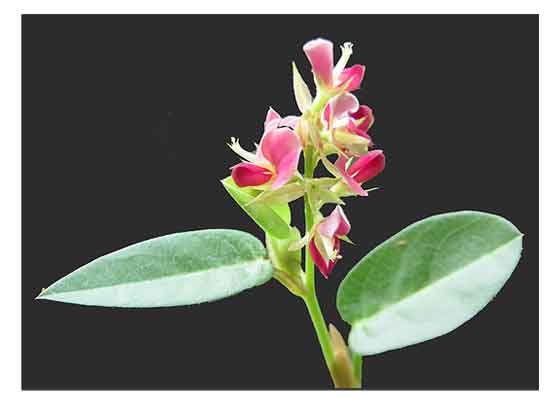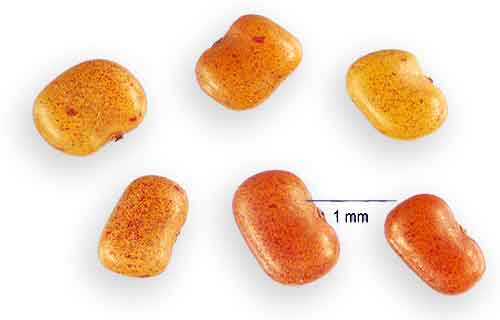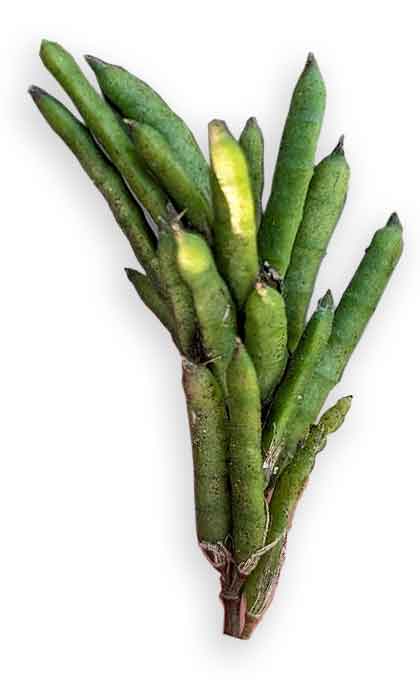 Gen info Gen info
- Alysicarpus is a genus of flowering plants in the legume family, Fabaceae. Species are generally known as moneyworts. Unusual for legumes, the leaves are simple, rather than compound. As of 2023, POWO lists 37 species. (3)
- Alysicarpus vaginalis common names include: alyce clover, buffalo clover, buffalo-bur, one-leaf clover, and white moneywort.
Botany
• Alysicarpus vaginalis is an annual or perennial herb; different varieties may be either annual or perennial, and some behave as perennials in wet conditions but grow as annuals in dry regions. Stems are erect or run along the ground, but more often erect when growing in dense stands, reaching one meter in length and usually have branches. Leaves are not divided into leaflets. Blades are variable in shape and up to about 6.5 centimeters long. Raceme are of up to 12 flowers occurring at the stem tips and grow from the leaf axils. Flower corolla is half a centimeter long and can be shades of red, purple, blue, or yellow. Fruit is a lightly hairy, cylindrical but compressed legume pod up to 2.5 centimeters long. Seeds are dark red, no more than 1.5 millimeters long. (3)
 • Herbs, perennial. Stem erect or procumbent, 30-90 cm tall, glabrous or slightly pubescent. Leaves 1-foliolate; petiole 5-14 mm, glabrous; blade often ovate-oblong or oblong-lanceolate to lanceolate, to 6.5 × 1-2 cm on upper stem, cordate, nearly orÂbicular, or ovate, 1-3 × ca. 1 cm on lower stem, abaxially slightly pubescent, adaxially glabrous. Racemes axillary or terminal, 1.5-7 cm, 6-12-flowered, binate at each node; interÂnodes 2-5 mm. Pedicel 3-4 mm. Calyx 5-6 mm, slightly longer than first article of legume. Corolla red, reddish purple, purplish blue, or yellow, slightly longer than calyx, ca. 5 mm; standard obovate. Ovary pubescent, 4-7-ovuled. Legume compressed, cylindric, 1.5-2.5 cm × 2-2.5 mm, pubescent, 4-7-jointed, not constricted between articles, with raised linear ridges. Seeds ellipsoidal, slightly compressed. (Flora of China) • Herbs, perennial. Stem erect or procumbent, 30-90 cm tall, glabrous or slightly pubescent. Leaves 1-foliolate; petiole 5-14 mm, glabrous; blade often ovate-oblong or oblong-lanceolate to lanceolate, to 6.5 × 1-2 cm on upper stem, cordate, nearly orÂbicular, or ovate, 1-3 × ca. 1 cm on lower stem, abaxially slightly pubescent, adaxially glabrous. Racemes axillary or terminal, 1.5-7 cm, 6-12-flowered, binate at each node; interÂnodes 2-5 mm. Pedicel 3-4 mm. Calyx 5-6 mm, slightly longer than first article of legume. Corolla red, reddish purple, purplish blue, or yellow, slightly longer than calyx, ca. 5 mm; standard obovate. Ovary pubescent, 4-7-ovuled. Legume compressed, cylindric, 1.5-2.5 cm × 2-2.5 mm, pubescent, 4-7-jointed, not constricted between articles, with raised linear ridges. Seeds ellipsoidal, slightly compressed. (Flora of China)
• Growth form: Herbaceous plant with a creeping growth habit. Foliage: Simple, oval-shaped leaves with entire leaf margin. Mostly green with a whitish streak along the midvein. Flowers: Pea-like flowers are reddish yellow or light purple (6 mm long). Fruit: Long, thin pods have distinct segmentation between seeds. Dark red seeds are oval to oblong (1 - 1.5 mm long). (13)
Distribution
- Native to the Philippines.
- Widespread in the Philippines, especially in areas subjected to a least a short annual dry season. Low elevation, along roadsides, grasslands, cultivated lands, etc. (2)
- Also native to Angola, Assam, Bangladesh, Benin, Bismarck Archipelago, Borneo, Burkina, Cambodia, Cameroon, Central African Republic, Chad, China South-Central, China Southeast, Comoros, Congo, East Himalaya, Equatorial Guinea, Gabon, Ghana, Gulf of Guinea Is., Gulf States, Hainan, India, Jawa, Kenya, KwaZulu-Natal, Laccadive Is., Laos, Lesser Sunda Is., Madagascar, Malaya, Maldives, Mauritania, Mauritius, Mozambique, Myanmar, Nansei-shoto, Nepal, New Guinea, Niger, Nigeria, Northern Provinces, Oman, Rodrigues, Rwanda, Réunion, Sierra Leone, Socotra, Solomon Is., South China Sea, Sri Lanka, Sudan, Sumatera, Swaziland, Taiwan, Tanzania, Thailand, Togo, Uganda, Vietnam, West Himalaya, Yemen, Zambia, Zaïre, Zimbabwe. (1)
 Constituents Constituents
- Phytochemical screening of methanol extract revealed presence of steroids, flavonoids, polyphenols, terpenoids, carbohydrates, alkaloids, and tannins. (6)
- GC-MS analysis yielded nine phytochemicals, six of which were found medicinally important with usefulness as anticancer to anti-inflammatory: 4-O-Methylmannose, Undecane, Neophytadiene, 2-amino-5-[(2-carboxy) vinyl]- Imidazole, Lup-20(29)-en-3-one and stigmasterol. (6)
- Phytochemical screening of ethyl acetate (EA) and methanol (M) extract of leaves yielded: flavonoid (M), tannin (EA, M), alkaloids (EA, M), saponin (M), carbohydrate (EA, M), glycoside (EA, M), reducing sugar (EA, M), gum (M), with absence of steroid. (see study below) (7)
- Phytochemical screening of methanol extract of roots showed presence of flavonoids, glycosides, alkaloids, steroids, terpenes, saponins, and tannins. (see study below) (10)
- GC-MS analysis of benzene, aqueous, and ethanol extracts of leaves identified 7 compounds with (R)-(+)-gamma-caprolactone (37.40%) and 1,14-tetradecanediol (26.98%) as major compounds. (see study below) (11)
Properties
- Studies have suggested anticancer, chemomodulatory, antioxidant, antibacterial, antinociceptive, neuropharmacological, hepatoprotective, anti-fertility properties.
Parts used
Roots, seeds, leaves.
Uses
Edibility
- Leaves eaten as famine food.
Folkloric
- Root decoction used for coughs. Roots chewed for treatment of fever. Infusion of powdered seeds used as remedy for dysentery and colic. Whole plant used for treatment sword wounds and bone fractures. (4)
-Juice from whole plant or dried parts prepared as tea for treatment of gallstones and urinary disorders.
- In Sri Lanka, porridge prepared from whole plant taken for kidney disorders. Also used for treatment of leprosy and pulmonary disorders. (12)
- In eastern Himalaya, roots are used by the Lepcha tribe of Sikkim in juice form as contraceptive herbal drug to check conception. (see study below) (14)
- In Jamaican folk medicine, used for boosting libido.
- In Tamilnadu, India, the Paliyar tribes use root juice with milk for treatment of fever. (15)
- In Jamaica, one of many plants used for common colds and influenza. (16)
- In Uttar Pradesh, India,
used for treatment of bronchitis, pneumonia, typhoid cancer, weak eye sight, joint pains, bone fractures. etc. (18)
Others
- Fodder: Grown in pastures as forage for livestock; sometimes cut for hay. Cattle and horses find it palatable; and in one trial, sheep found it as palatable as alfalfa. Plant is very tolerant of grazing and mowing. (3)
- Yield: The crop yields up to six tons of hay per hectare. It can yield about 300 kg of seeds per hectare.
- Agroforestry: To improve nitrogen fixation for soil improvement, seeds can be inculated with rhizobia use for cowpeas. (3) Used as cover crop and for erosion control.
Studies
• Anticancer Against Breast Cancer Cell Lines: Study evaluated the anticancer potential of Alysicarpus vaginalis ethyl acetate fraction (AVEAF) in breast cancer cell lines (MCF-7 and
MDA-MB-453 and against N-methyl-N-nitrosourea (MNU) induced mammary carcinoma in Sprague-Dawley rats, which resemble human estrogen dependent breast cancer. SRB assay showed maximum growth inhibition rate of AVEAF on MCF-7 cell was 27.12 at 100 µg/mL. Flow cytometry analysis showed AVEAF induced cell cycle arrest at the S phases and decreased mitochondrial membrane potential on MCF-7 cells. Results suggest AVEAF exhibits invitro and invivo anticancer activities that is associated with its ROS-mediated mitochondrial-mediated intrinsic pathway of apoptosis and necroptosis in MCF-7 cells and may serve as a potential against breast cancer. (5)
• Antioxidant / Antibacterial / Cytotoxic / Neuropharmacological / Leaves: Study evaluated ethyl acetate (EA) and methanol ME) leaf extracts for invitro antioxidant, antimicrobial, cytotoxic, analgesic, and neuropharmacological properties using Swiss albino mice. The ME showed highest antioxidant activity by DPPH radical scavenging assay with IC50 of 34.70 µg/mL. For antibacterial activity against B. cereus, S. aureus, E. coli, P. aeruginosa and K. pneumonia, both extracts varying degrees on inhibition zones. In brine shrimp lethality bioassay, both extracts showed notable lethality with LC50s of 3.89 and 8.71 µg/mL compared to vincristine sulphate LC50. EAEAV reduced peripheral nociception in acetic acid-induced writhing with % inhibitions of 42.48% and 47.00% while MEAV reduced by 40.63% and 51.77% compared to diclofenac sodium. Considerable analgesic effect was seen in hot plate test. Extracts also showed reduced motor coordination in Open Field and Hole Cross Test. (see constituents above) (7)
• ESR Signaling Pathway Inhbitor for Breast Cancer Treatment: In silico, invitro and invivo studies evaluated A. vaginalis for potential targets for breast cancer treatment. A network pharmacology (NP) approach involves prediction and validating targets via molecular modeling, western blotting and In-vivo MNU-induced mammary cancer. GO and KEGG enrichment analysis predicted the ERR, c-MET, PDGFR-α/ß, EGFR, and VEGF as key targets in breast cancer treatment, which are validated via molecular modeling. Expression of ER-α, AR and EGFR were down-regulated by AV in MCF-7 cell line. Immunoreactivity of ER-α was significantly reduced in MNU-induced mammary carcinoma, which is a key target in ER+ breast cancer. Study scientifically elucidates the pharmacological mechanism of AV in the treatment of breast cancer, which is strongly associated with the regulation of ESR signaling pathway. (8)
• Hepatoprotective in Nitrobenzene-Induced Hepatotoxicity: Study evaluated the hepatoprotective activity of ethanol extract of A. vaginalis aerial parts in NB-induced hepatic injury in Wistar rats. Silymarin was used as standard drug. Extract doses of 200 mg/kg orally significantly (p<0.05) and dose-dependently reduced and normalized serum marker enzymes and increased antioxidant enzyme status, with histopathological confirmation. (9)
• Antibacterial Against Respiratory Tract Pathogens / Roots: Study evaluated the antibacterial activity of various root extracts of A. vaginalis against common respiratory pathogens i.e. Staphylococcus aureus, Streptococcus pneumoniae, S. pyogenes, Klebsiella pneumonia, and Pseudomonas aeruginosa. A methanol extract showed more efficient effect. ZOI ranged between 10 to 13 mm at 200 mg/ml. MIC for methanol extracts were between 3.12 to 25 mg/ml for all pathogens. Results suggest potential for use in the treatment of respiratory tract infections. (see constituents above) (10)
• Antioxidant / Leaves: Study evaluated the phytochemicals and antioxidant activity of aqueous, ethanol, and benzene leaf extracts of A. vaginalis. The benzene extract showed highest antioxidant activity followed by ethanol and aqueous extracts. GC-MS analysis identified 7 compounds with (R)-(+)-gamma-caprolactone (37.40%) and 1,14-tetradecanediol (26.98%) as major compounds. (11)
• Antifertility / Anti-Implantation / Roots: Study evaluated roots of Alysicarpus vaginalis and Momordica dioica for antifertility effects in Wistar rats using doses of 150 and 300 mg/kg. Implantation of zygote requires exact equilibrium of estrogen and progesterone and any disturbance in these hormone levels may cause infertility. Both extracts showed antifertility effects with significant inhibition of number of implants. Loss of implantation caused by both extracts may be due to antizygotic or blastocytotoxic activity. (14)
• Cytotoxicity Against HepG2 Cell Line / Antioxidant / Hepatoprotective / Anti-Implantation / Whole Plant: Study evaluated hexane (AVH), ethyl acetate (AVE), and methanol (AVM) extracts from dried and powdered whole plant material for invitro cytotoxicity, antioxidant potential, and hepato-protective activity. Invitro cytotoxicity showed IC50s of AVH, AVE, and AVM extracts of 55.26, 41.51, and 112.6 µg/ml respectively. Significant dose dependent increase in percentage viability of HepG2 cells was seen at dose of 6.25, 12.5 25, 50 and 100 µg/mL of the different extracts compared to CCl4 (0.1%) exposed cells. AVM showed high hepatoprotective activity with dose dependent action. The AVE and AVM showed higher antioxidant activity. The AVM showed higher hepatoprotective effect than the two other extracts. (17)
• Silver Nanoparticles / Antimicrobial: Study reports on the green synthesis of AgNPs using Alysicarpus vaginalis alcoholic extract as a reducing agent and capping ligand. The AgNPs showed 1,2 ti 1,4-fold enhanced antibacterial activity than the extract (6-10 mm inhibition zone) against Staphylococcus. aureus, Pseudomonas aeruginosa, Listeria monocytogenes, and Salmonella enterica. The AgNP formulation F9 showed equal or better antimicrobial activity than positive control, ciprofloxacin. Study suggests potential for F9 for a broad-spectrum, cost-effective natural antibacterial formulation. (19)
Availability
Wild-crafted.
|

 Constituents
Constituents![]()





